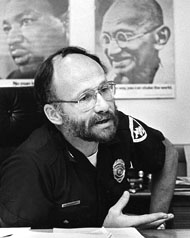Here is the Introduction to my third edition. (You might want to send a copy of this book either the paperback or a Kindle to a friend who Is a police officer, local politician, or community organizer.)
Also a new chapter: “George Floyd: Where to from Here?” In this book I suggest a way forward. Much of what I have written is contained in this blog which began in 2011 and now have over 1,500 posts and has been viewed over 500,000 times. But after George Floyd’s murder in Minneapolis and hundreds of other questionable uses of police force since 2015 when Michael Brown was killed in Ferguson, more needed to be said.
________________________________________________
“Much has transpired in American policing since the first publication of this book in 2012. There was the Occupy Movement (during the book’s final stages in 2011), the killing of Michael Brown in 2014, and then our nation (and a good part of the world) raised its collective conscience after watching George Floyd’s death in 2020. This focus on Floyd’s death continued to conviction of Minneapolis Police Officer Derek Chauvin the following year.
“If American policing should have learned anything during this decade of police uses of force is that the way things are being done are not producing their intended result: using force to quell an assembly of relatively peaceful protesters does not work and killing an inordinate number of Black youths does not bring about their compliance (let alone their trust and support).
“A style of policing that depends on the threat of deadly force is not one that should exist in a free and democratic political system; especially one that is becoming more and more diverse and less and less white.
“What I have proposed to improve, even transform, policing is a style that is harmonious with the national values we proclaim as ‘we the people.’ We developed this system of policing in Madison, Wisconsin through the early 1970s and into the 1990s. It is a system of delivering democratic, community-oriented police services in a city of a quarter of a million residents in which, where approximately 10 percent of the population are citizens of color. Nearby, 40,000 students attend the University of Wisconsin.
“Madison was and is a progressive city which considers itself quite liberal. Yet a recent study of Madison and Dane County, called ‘Race to Equity,’[1] revealed that all is not well in Mad City. Instead, the report uncovered
…the pervasiveness and the extremity of the county’s black-white disparities, which are generally more extreme than those found in most other jurisdictions across the state and nation. There is not a single indicator that we analyzed in which African American well-being is on par with that of whites. In many ways, of course, this should not be unexpected. The hard truth is that African Americans fare worse than whites on virtually all status indicators in virtually every part of the nation. What is extraordinary about Dane County’s numbers, however, is the sheer magnitude of the disparities that we found in many of the most fundamental status indicators.
“To many who lived and worked in Madison and Dane County, this was a wake-up call that soon dissipated. The overall community attitude was one of ‘Yes, things might be difficult for people of color in our city, but we are certainly better than other cities!’ This turned out not to be true.
“In light of this information and what we are learning about Alexander Hamilton, ‘redlining,’ the sheer number of lynchings throughout the country (from Selma to Duluth), the Tulsa massacre, and other race-biased actions is that we live in a racist society that is both historical and present.
“It is precisely within that system that our nation’s police must operate and must understand and acknowledge how bias (much of it unconscious) affects those of us who call ourselves white and benefit from a racial privilege.
“It is possible to cease the bondage in which we put our police who must work in this system and liberate them so they become more effective and supported. Whether we like it or not, police are in a position in our society to either undermine or reinforce the dominate values we profess as a nation: ‘truth, justice and the American way!’ (Which, incidentally, comes from my boyhood and Superman comics!) Nevertheless, the origins of these values are found in our Declaration of Independence and our Constitution. We Americans do believe we are the “good guys” in the world, that our system of government is the best: a “government of the people, by the people and for the people.” We can accentuate these values by improving our police.
“This has always been my dream. From that spring day in 1960 when a young Marine came off active duty, took an oath of honor, became a police officer, and continued to be one for the next 33 years. We can make our dreams come true. But in order to do that, we must strongly believe in them and persist in making them become real.”
You may order the book HERE.
[1]. https://racetoequity.net/wp-content/uploads/2016/11/WCCF-R2E-Report.pdf



1 Comment